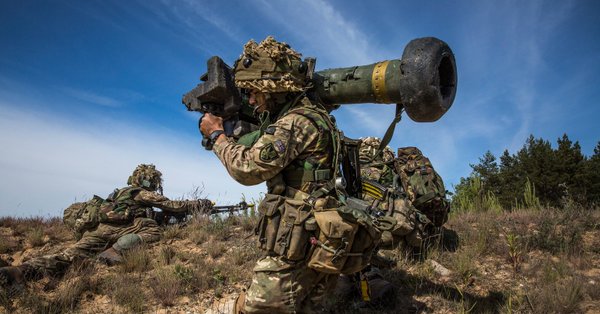Libyan government fighters discovered a cache of powerful American missiles, usually sold only to close American allies, at a captured rebel base in the mountains south of Tripoli this week.
Publish dateSunday 30 June 2019 - 09:17
Story Code : 187519
The four Javelin anti-tank missiles, which cost more than $170,000 each, had ended up bolstering the arsenal of Gen. Khalifa Hifter, whose forces are waging a military campaign to take over Libya and overthrow a government the United States supports.
Markings on the missiles’ shipping containers indicate that they were originally sold to the United Arab Emirates, an important American partner, in 2008.
If the Emirates transferred the weapons to General Hifter, it would likely violate the sales agreement with the United States as well as a United Nations arms embargo.
Officials at the State Department and Defense Department said Friday they had opened investigations into how the weapons ended up on the Libyan battlefield.
“We take all allegations of misuse of U.S. origin defense articles very seriously,” a State Department official said in a statement. “We are aware of these reports and are seeking additional information. We expect all recipients of U.S. origin defense equipment to abide by their end-use obligations.”
The United States supports United Nations-led efforts to broker a peaceful solution to the Libyan crisis, the official added.
A spokeswoman for the Department of Defense declined to comment further on the matter.
The United Arab Emirates ambassador to Washington, Yousef al-Otaiba, declined to answer questions about the provenance of the missiles.
The missiles were discovered after forces loyal to the United Nations-backed national unity government carried out a successful surprise attack Wednesday on Gheryan, a mountain redoubt 40 miles south of Tripoli. Gheryan was the headquarters for General Hifter’s military campaign to seize control of Tripoli, which his forces have been fighting since April.
After capturing Gheryan, pro-government fighters uncovered Chinese-made attack drones and the stack of four American-made Javelin missiles at an abandoned base. Known in the military as “fire and forget” weapons, the Javelins are guided by infrared technology and are capable of destroying all currently fielded main battle tanks.
Markings on the missile crates identify their joint manufacturer, the arms giants Raytheon and Lockheed Martin, and a contract number that corresponds with a $115 million order for Javelin missiles that was placed by the United Arab Emirates and Oman in 2008
Oman is not a player in Libya’s wars. But the United Arab Emirates, under its de facto leader Prince Mohammed bin Zayed, is one of General Hifter’s most committed foreign backers.
Emirati warplanes carried out airstrikes in 2017 that helped General Hifter win control of Benghazi, after years of battle against Islamist militias that leveled entire swaths of the eastern city.
When General Hifter started his assault on Tripoli on April 4, in the face of much international opposition, the Emiratis continued to support him. They supplied a Russian-made surface-to-air missile system, Chinese-made Wing Loong combat drones and Emirati drones, said a senior Western official with knowledge of the arms trade.
Jordan, another American ally to side with General Hifter, sent a Jordanian-made anti-tank system known as Nashshab, the official said.
Turkey, a regional rival of the United Arab Emirates, intervened on the other side of the fight, sending combat drones and armored vehicles to help the United Nations-backed government in Tripoli.
The United States supports the Tripoli government, which it helped install. However, President Trump appeared to endorse General Hifter and his military drive after the two men spoke by telephone in April, hailing his “significant role in fighting terrorism.”
Other American officials later rowed back that position by stressing American support for the United Nations-led political process.
The foreign interventions, which flout a United Nations embargo on all arms sales to Libya, highlight how the conflict set off by the ouster of Libya’s longtime dictator, Col. Muammar el-Qaddafi, in 2011 has partly devolved into a proxy conflict between rival regional powers.
Until now, though, those foreign sponsors have avoided using restricted American military technology
“The U.A.E. has been supplying advanced weapons to the Libyan theater for years,” said Oded Berkowitz, an Israeli security analyst who specializes in the Libyan conflict. “But now they seem to be throwing everything at it. And some of these weapons, like the Javelins, are real game changers.”
The controversy over the Javelin missiles suggests that the Emiratis are flexing their military muscle with little regard for rules set by their American allies, said Frederic Wehrey, a scholar at the Carnegie Institute and author of a recent book on Libya.
“This is the new era we’re in,” he said.
The Emiratis have used restricted American weapons in Libya before. In 2014, American officials were alarmed when Emirati warplanes bombed targets in western Libya with American munitions, said Deborah Jones, then the United States ambassador to Libya.
Criticism of the Emirati actions from the Obama administration made Prince Mohammed “furious,” recalled Ms. Jones, who was sent to Abu Dhabi to meet with him.
President Trump, though, has had a much closer relationship with his Emirati and Saudi allies in the Persian Gulf, a closeness that has left some wondering if it has emboldened the Emiratis in Libya.
“When the Emiratis bombed Tripoli in 2014 there was alarm in the Pentagon and an effort to warn them off,” Mr. Wehrey said. “But in the current climate, you have to wonder if they perceive such a cost.
Source : nytimes
avapress.net/vdca60n6o49nam1.tgk4.html
Tags
Top hits







